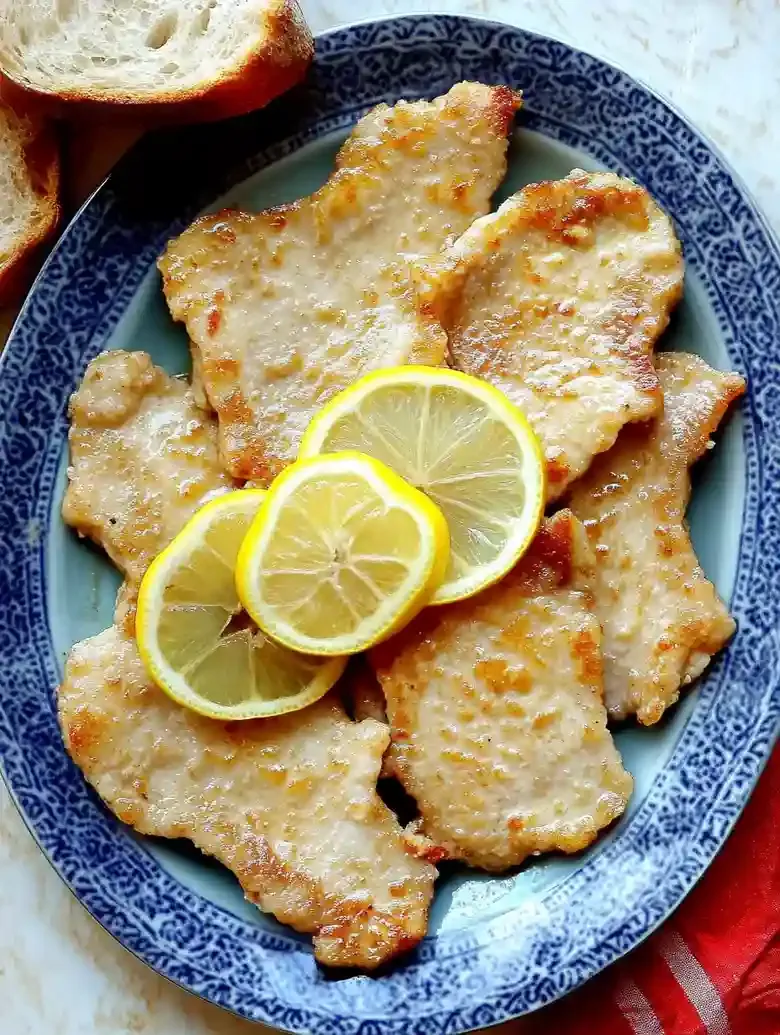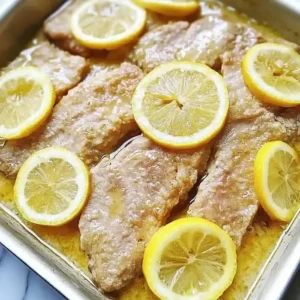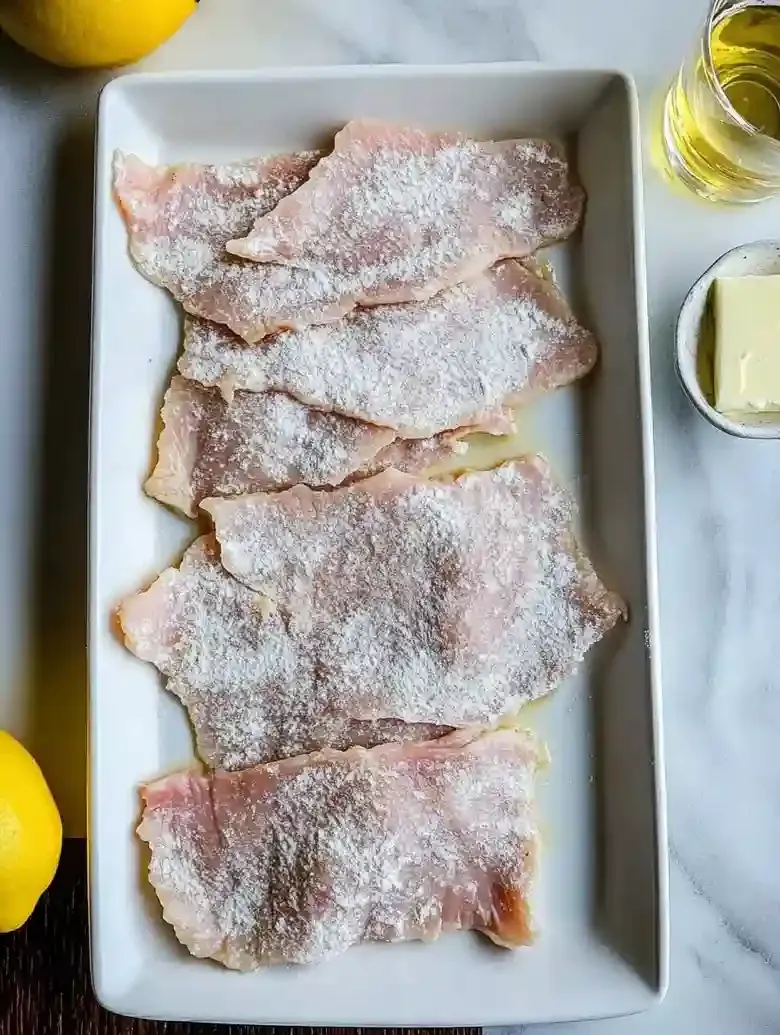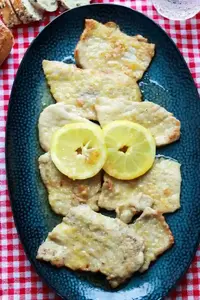Scaloppine al Limone is a classic Italian dish that brings tender veal fillets right to your table, drizzled with a bright and tangy lemon sauce. It’s simple yet bursting with flavor, perfect for any weeknight.
This recipe resolves issues of unclear instructions, ingredient measurements, and provides beginner-friendly tips, ensuring a more enjoyable cooking experience for all.

I found that cooking scaloppine can sometimes lead to overcooked meat or a bland sauce, but this recipe sidesteps those issues. It’s been a lifesaver during busy evenings when I need something quick but still delicious for my family.
This recipe comes together in just about 20 minutes, allowing for perfectly cooked veal that’s tender inside with a zesty finish. It’s a reliable choice that delivers every time, making it worth your while.
If you’re looking for an easy side to pair with your scaloppine, check out my homemade garlic bread.
Table of contents
Dietary Considerations
- This recipe is not gluten-free due to the flour used for coating the veal cutlets.
- The recipe contains eggs and butter, so it is unsuitable for vegan diets.
- This recipe does not meet dairy-free requirements because it requires butter in the sauce preparation.
- The recipe is not keto or low-carb friendly as it includes flour and white wine in the preparation.
- The recipe is nut-free, containing no nuts or nut-derived ingredients in any part of the preparation.
Why You Will Love This Recipe
- Quick and Easy Preparation This dish requires minimal time and effort. With just 10 minutes to prep and 10 minutes to cook, you can enjoy Scaloppine al Limone on a busy weeknight without stress.
- Fresh and Zesty Flavor The bright lemon juice and slices in this recipe bring a burst of refreshing flavor. Each bite gives you that perfect tanginess that pairs beautifully with the tender veal.
- Light and Crispy Texture Dredging the veal fillets in flour creates a light golden crust when fried. This adds a satisfying crunch that contrasts beautifully with the melt-in-your-mouth tenderness of the meat.
- Comforting Culinary Heritage Scaloppine al Limone showcases Italian culinary tradition, making it not just a meal but also a taste of Italy’s rich gastronomic culture. It’s a dish that evokes memories of homemade meals and family gatherings.

How to Make Scaloppine Al Limone
- Prep Time: 10 minutes
- Cool Time:
- Cook Time: 10 minutes
- Total Time: 20 minutes
- Yield: 4 servings 1x
- Category: Main Course
- Method: Pan-frying
- Cuisine: Italian
- Diet: Low Salt
Description
Quick and Tasty Veal Scaloppine al Limone is a classic Italian dish that combines tender veal with a zesty lemon sauce.
Ingredients
- 8 veal fillets, cut to about an ⅛ inch (3 mm) thickness
- ½ cup (60 g) type “00” flour
- 2 Tbsp (30 ml) extra virgin olive oil (EVOO)
- 1 lemon (juice and slices)
- ⅛ cup (30 ml) white wine
- 1 Tbsp (14 g) butter
- Fine sea salt, to taste
- Fresh cracked pepper, to taste
Instructions
- Step 1: Pound the Veal: Wrap each veal fillet tightly in plastic wrap. Using a meat cleaver, gently pound the fillets working from the center outward until the meat reaches about ⅛ inch (3 mm) thickness. Flip and pound the other side in the same manner. This ensures even cooking and tender texture.

- Step 2: Season Generously: Unwrap the fillets and place them on a plate. Season both sides well with fine sea salt and fresh cracked pepper according to taste.

- Step 3: Prepare the Flour: In a shallow bowl, combine ½ cup (60 g) type “00” flour with salt and pepper to taste. Whisk thoroughly until the seasoning is evenly distributed throughout the flour. This prevents clumping and aids in an even coating.

- Step 4: Dredge the Veal: Place each seasoned veal fillet into the seasoned flour, coating both sides completely. Shake off all excess flour and arrange fillets on a clean dish. Repeat until all fillets are dredged.

- Step 5: Heat the Oil: Drizzle 2 tablespoons (30 ml) of extra virgin olive oil into a large deep sauté pan. Heat over medium-high until the oil is shimmering and hot enough to sauté without sticking.

- Step 6: Fry the Fillets: Carefully add the veal fillets to the hot oil without overcrowding. Fry each fillet for 2 minutes on one side until golden brown, then flip and cook for another 1 minute. The fillets should be a rich golden-brown color indicating doneness. Remove and place on a clean dish. Repeat for all fillets.

- Step 7: Deglaze the Pan: Reduce heat to low. Pour ⅛ cup (30 ml) white wine into the pan. Using a wooden spoon, scrape up all caramelized browned bits from the bottom of the pan. This builds depth to the sauce.

- Step 8: Make the Sauce: Add 1 tablespoon (14 g) butter and two slices of lemon to the pan. Let the mixture simmer gently for a couple of minutes until the butter is fully melted and incorporated with the lemon.

- Step 9: Combine and Serve: Return the veal fillets to the pan. Squeeze fresh lemon juice over the top of the fillets. Turn off the heat and turn the fillets to coat them evenly with the sauce. Transfer the veal scaloppine onto a serving platter. Pour any remaining pan juices over the fillets, then arrange the lemon slices on top.

Notes
- Room Temperature: Store scaloppine al limone uncovered in an airtight container up to 1 day to avoid drying out.
- Refrigeration: Keep in an airtight container and refrigerate up to 3 days. Reheat gently on low heat to maintain texture.
- Freezing: Wrap portions tightly in plastic wrap and place in a freezer-safe container for up to 2 months. Thaw overnight in the refrigerator before reheating.
- To ensure evenly thin veal, pound fillets to approximately ⅛ inch (3 mm) thickness 3–5 minutes before cooking.
- Heat oil on medium-high for about 5 minutes until shimmering to avoid sticking and help achieve a crisp crust.
- If the sauce reduces too quickly, lower the heat and add 1 tablespoon (15 ml) white wine every minute until desired consistency is reached.
- For proper browning, make sure veal fillets are dry before dredging. Use seasoned flour mixture for coating.
- Reheat leftovers gently on low heat to preserve the veal’s tenderness and texture.
- Serve with a light arugula salad or sautéed spinach for freshness.
- Pair with roasted potatoes or lemon-infused quinoa for textural contrast.
- Use leftovers to make veal sandwiches or add to pasta with fettuccine, risotto, or vegetable stir-fry.
- Garnish with extra lemon slices or fresh parsley. For richness, drizzle with a balsamic reduction or caper sauce.
- If veal is unavailable, thinly sliced chicken or turkey cutlets can substitute evenly.
- This recipe is not gluten-free due to flour coating; use gluten-free flour blends if necessary (note: such substitution is outside provided measurements).
- Contains eggs and butter; therefore, it is unsuitable for vegan and dairy-free diets.
- Not compatible with keto or low-carb diets because of flour and white wine used.
- The recipe is nut-free and suitable for nut allergy considerations.
- Choose thinly sliced veal with a light pink color and fine grain for best texture.
- Use type “00” flour for a finer, crisp coating.
- Fresh lemons with bright skin provide optimal flavor and aroma.
- Dry white wine such as Sauvignon Blanc or Pinot Grigio contributes balanced acidity.
- Unsalted butter browns well to enrich the sauce; keep cold until ready to use.
Nutrition
- Serving Size: 1 serving
- Calories: 350
- Sugar: 1g
- Sodium: 600mg
- Fat: 20g
- Saturated Fat: 7g
- Unsaturated Fat: 10g
- Trans Fat: 0g
- Carbohydrates: 15g
- Fiber: 1g
- Protein: 30g
- Cholesterol: 90mg

Ingredient Notes
- Veal cutlets: Choose thinly sliced veal for a tender finish. Look for light pink color and fine grain. If unavailable, chicken or turkey cutlets work well as substitutes.
- Flour: All-purpose flour is ideal for dredging. It helps create a crispy outer layer. Make sure it’s fresh and finely milled for the best texture.
- Eggs: Use one large egg, preferably at room temperature, to help the coating adhere nicely to the meat. This adds richness and moisture to your dish.
- Butter: I suggest unsalted butter for its rich flavor. It browns beautifully, enhancing the sauce. Keep it cold until you’re ready to cook for a great texture.
- Lemon: Fresh lemons provide the tangy zing that’s key to flavor. Look for firm lemons with bright skin. You’ll use both zest and juice for optimal taste and aroma.
- White wine: A dry white wine balance acidity in the sauce. Sauvignon Blanc or Pinot Grigio are excellent options. If you prefer not to use wine, chicken broth can substitute.
- Capers: Look for non-pareil capers for their small size and ideal briny kick. Rinse them well to reduce saltiness. They add a punch of flavor that’s key in this dish.
- Parsley: Fresh flat-leaf parsley works beautifully for garnish and adds a fresh note. Avoid wilted leaves; choose vibrant, green parsley for the best pop of color and taste.
Recipe Tips
- If the veal fillets are too thick, aim for ⅛ inch by pounding evenly from the center 3-5 minutes before cooking.
- When the oil isn’t shimmering, heat it on medium-high for about 5 minutes or until ready to sauté the veal.
- If the sauce reduces too quickly, lower the heat and add 1 tablespoon of white wine every minute until you achieve desired consistency.
- If the veal isn’t browning, ensure it’s dry before dredging in ½ cup seasoned flour for crispiness during cooking.
- If leftovers remain, store them in an airtight container in the fridge for up to 3 days to maintain flavor and moisture.
Serving Suggestions
Serve with a light arugula salad or sautéed spinach for a fresh contrast. Add roasted potatoes or lemon-infused quinoa for texture.
Use to make veal sandwiches or serve in a pasta dish with fettuccine. Add to risotto or a vegetable stir-fry.
Top with extra lemon slices or fresh parsley for brightness. Drizzle with a balsamic reduction or caper sauce for richness.
Recipe variations
- You can use chicken or pork cutlets instead of veal for scaloppine al limone, adjusting thinness to about ⅛ inch for quick and even cooking.
- Add fresh thyme or rosemary sprigs with the lemon slices in the butter sauce to give a subtle herb flavor, using about 1 teaspoon of finely chopped herbs.
- Either dry white wine or low-sodium chicken broth can replace wine in the sauce; if using broth, add 1 tablespoon lemon juice for brightness.
- If making scaloppine al limone for more servings, double ingredients accordingly but cook fillets in batches to avoid overcrowding in the pan and maintain crispiness.
Save This Recipe!
How to Store?
To keep your scaloppine al limone fresh and delicious, follow these storage tips:
Room Temperature: Store in an airtight container at room temperature up to 1 day. Avoid leaving scaloppine uncovered to prevent dryness.
Refrigeration: Place scaloppine al limone in an airtight container and refrigerate up to 3 days. Reheat gently on low heat to maintain texture.
Freezing: Wrap portions tightly in plastic wrap and place in a freezer-safe container for up to 2 months. Thaw overnight in the refrigerator before reheating.
Other Recipes You’ll Love
If you enjoyed this Scaloppine al Limone or any other recipe on my blog, please leave a ⭐ star rating and let me know how it went in the comments below. I appreciate taking time to read about this recipe, thank you!
